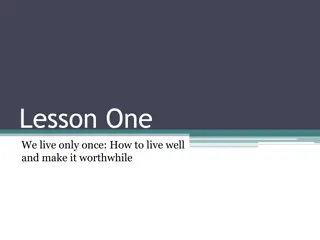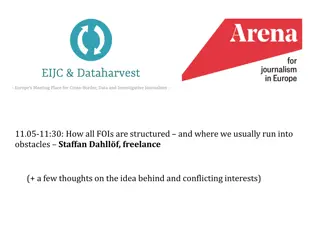Overcoming Obstacles to Committed Action in Practice
Explore the barriers faced by clients and therapists in practicing committed action, as discussed by Sonja V. Batten, Ph.D., Patricia A. Bach, Ph.D., and Daniel J. Moran, Ph.D. Learn how to identify and overcome common obstacles such as experiential avoidance, cognitive fusion, mindlessness, unclear values, and more.
Download Presentation

Please find below an Image/Link to download the presentation.
The content on the website is provided AS IS for your information and personal use only. It may not be sold, licensed, or shared on other websites without obtaining consent from the author.If you encounter any issues during the download, it is possible that the publisher has removed the file from their server.
You are allowed to download the files provided on this website for personal or commercial use, subject to the condition that they are used lawfully. All files are the property of their respective owners.
The content on the website is provided AS IS for your information and personal use only. It may not be sold, licensed, or shared on other websites without obtaining consent from the author.
E N D
Presentation Transcript
Committed Action in Practice: Identifying and Overcoming Client and Therapist Barriers to Committed Action Sonja V. Batten, Ph.D. Patricia A. Bach, Ph.D. Daniel J. Moran, Ph.D. Peer-reviewed ACT Trainers Past-Presidents and Fellows, Association for Contextual Behavioral Science
Disclosures (support): Relevant Financial Relationships: Moran, Bach, and Batten all receive royalties from New Harbinger publications for a book co-written on a topic similar to the subject of this presentation Batten employed by Booz Allen Hamilton Bach employed by the Carter Psychology Center Moran employed by Pickslyde Consulting and MidAmerican Psychological Institute
Disclosures (no support): Daniel J. Moran, Sonja V. Batten, Patricia A. Bach I have not received and will not receive any commercial support related to this presentation or the work presented in this presentation. Relevant Nonfinancial Relationships Moran, Bach, and Batten have all served as Past-President of the Association for Contextual Behavioral Science
References The work we ll be presenting today is based largely on: Committed Action in Practice Moran, Bach, & Batten (Context Press: 2018)
Committed Action is intertwined with all of the other processes on the hexaflex, both facilitating them and being facilitated by them
Identifying Obstacles to Committed Action on the Part of the Client: The Inflexahex
Sample obstacles to committed action on the part of the client I didn t feel like it (experiential avoidance) I was too anxious, depressed, angry, etc. (cognitive fusion) I forgot (mindlessness) It didn t seem important (unclear values) Too many other things seemed more important for me to do (inactivity, avoidance, and impulsivity) I wanted to, but it s just not for me (attachment to the conceptualized self)
Additional obstacles to committed action Lack of environmental supports Skills deficits
Addressing obstacles to committed action on the part of the client: Committed Action and Acceptance Clients may: Want to change private events (e.g., pain, mood) without changing behavior Want to change behavior without experiencing discomfort (e.g., losing weight, stopping substance use) Not accept the circumstances that brought them here Address avoidance and control agenda Work on small acts of acceptance
Addressing obstacles to committed action on the part of the client: Committed Action and Defusion Clients may: Convince themselves they can t act just yet Decide they re doomed to fail Miss opportunities for committed action if the opportunities don t fit with the stories they ve told themselves Focus on changing other people s behavior Classic defusion exercises Demonstrate the disconnect and lack of power of thoughts on behaviors in session
Addressing obstacles to committed action on the part of the client: Committed Action and Contact with the Present Moment Clients may: Focus inordinately on the future Focus excessively on the past In the case of depression and worry, focus on both past and future Go through the day in a mindless state Committed action can only take place in the present mindfulness can help Be mindfulness both of the process of committed action and opportunities to practice it
Addressing obstacles to committed action on the part of the client: Committed Action and Self-as-Context Clients may: Get caught up in their stories about who they are Feel defined by their thoughts, feelings, sensations, history Believe they can t act because of their thoughts, feelings, sensations, history Self-as-context exercises to provide space for new actions (e.g., Observer exercise, I am , sky with clouds, tree exercise)
Addressing obstacles to committed action on the part of the client: Committed Action and Values Clients may: Choose behaviors based on what feels good or avoiding what feels bad Set goals based on what others want or what they think they are expected to do Fail to keep values in mind as they have opportunities to choose effective action Values clarification to identify domains that are personally meaningful Visualization exercises related to values to charge and inspire actions
Addressing obstacles to committed action on the part of the client: Committed Action and Committed Action Clients may: Become overwhelmed by large goals that seem impossible Become stuck when trying to start changing longstanding patterns Choose dead man goals Starting with small committed actions to build larger patterns of committed action Engaging in many new, interconnected behaviors to build new patterns of behavior
Context and function influence the understanding of committed actions Taylor has committed to run an average of 30 minutes per day in the service of her value of improving and maintaining her health Values driven, very easily measurable However, measurement doesn t tell the whole story ..
How workable or effective is Taylors commitment to run in each scenario? She often reports that she wants to improve her health, and she is overweight, abuses alcohol, and smokes 10 cigarettes a day She s morbidly obese She s in treatment for panic attacks and her primary treatment goals are to improve anxiety management skills and find a new job She s a triathlete and typically runs 50 miles a week She s 62 years old and hasn t walked more than a mile at a time in over five years She made the commitment a few days after her sister (her chief rival) made the same commitment
Committed action must be considered in the context of history, presenting complaint, goals, and values. She returns the next week and . She didn t run because her physician advised her she should have a complete physical first She ran 30 minutes one day, skipped the next 5 days, and ran 3 hours on the 7th day She reports that meeting her goal was easy, because she usually runs 60 minutes a day She tells you she didn t run 30 minutes the day after she came down with the flu She tells you she didn t run 30 minutes per day because she felt too depressed She says that even though she was late to work 3 times because of her early morning running that she did keep her commitment
Therapist obstacles to facilitating committed action Discussion: what gets in your way?
Therapist obstacles to facilitating committed action Discomfort with being directive / with the process of homework Feeling that it is not compassionate to push someone at times Mismatch of therapeutic timing moving too quickly to committed action Failing to fully explore resistance or barriers Frustration with listening to a client s fused stories Frustration with lack of follow through by the client Feeling like the therapist doesn t have enough time to prepare Therapist feeling stuck in therapy Therapist well being outside of the therapy room (e.g., burnout, not following through with own committed actions)
Recognizing Therapist Barriers to Committed Action Work: Sticky thoughts She s already dealing with enough right now without me adding more for her to work on. I know he probably won t follow through anyway. This is so uncomfortable. We talk about the same thing every week, and she just refuses to do anything about it. It s not fair to him to ask him to do this. She probably won t be successful in this situation, even if she tries. The circumstances are just too complicated and out of her control. I can t figure out how to get him unstuck so that he ll listen to my suggestions.
Recognizing Therapist Barriers to Committed Action Work: Other Signs Sticky thoughts can serve as a signal that the therapist is fused with thoughts about the client or the process, rather than simply tracking what s likely to be effective and being willing to experiment to find what works Client seems to be frustrated with the therapist for pushing toward commitment Client demonstrates counterpliance may be a sign the client is not where the therapist thinks the client is with things The therapist is the one repeatedly coming up with the committed actions to work on, especially when the client is not following through the therapist may be gaining agreement through pliance rather than through the client s values
Overcoming Barriers to the Therapists Own Committed Action When the therapist finds himself at a stuck point, he should examine how well his approach to committed action is working for the client is the current approach getting the person closer to or further from the client s goals Therapists who are giving their clients a pass on following through with commitments should reflect on whether they are perhaps costing their clients time and lost opportunities by not following up If the therapist is fused with unhelpful thoughts or feelings of frustration, it may be time to practice therapist defusion and acceptance and again reconnect with the values of the client (and the therapist!) Mindfulness of the process can be very useful When in doubt bring up the barriers for discussion with the client thoughtfully and nonjudgmentally
Therapist Barriers to Effective Use of Homework Homework is an area where both clients and therapists can struggle with committed action However, without specific plans for applying new behaviors in real life, clients commitment to use the skills discussed in therapy can easily fade So, an important part of ACT is collaborating with clients to choose homework assignments for the week. Even when everyone understands why homework is useful, following through with homework assignments is easier said than done for both client and therapist
A Model for Homework in Therapy 1. The client and therapist collaboratively identify behavioral targets to be met by the client before the next session or within a specific time period 2. The client and therapist identify potential barriers that are likely to arise and could get in the way of accomplishing the target behaviors, and they develop strategies to address those barriers 3. The client makes a commitment to follow through with the identified behavioral targets 4. The client does (or does not) follow through with the planned behaviors 5. The therapist follows up in the next session to determine whether the client successfully accomplished the homework assignment 6. If the client followed through, the therapist works to ensure client awareness of and contact with the natural contingencies of the behavior. Or if the client didn t follow through or did so only partially, the therapist helps the client assess what the barriers were, and together, they make a plan to overcome those barriers in the future
Therapist Barriers to Effective Use of Homework Sometimes logistical barriers get in the way client and therapist should both have a written record of the same list of committed action goals at the end of the session, to facilitate follow up Some therapists are uncomfortable with having a predetermined session structure that sets aside time for follow up on the last session s homework, and discussion of the committed action goals for the following week Important to remember this process is for the client s interests Just like clients, some therapists may have a negative association with the word or concept of homework can choose other words (e.g., goals, commitments, targets, plans). The therapist may also need consultation Therapists may get overly invested in the outcome of a given commitment remember that commitments are only chosen by the client to extend the work of the client s life and do not reflect on the therapist or quality of therapy
Therapist Barriers to Effective Use of Homework There are many reasons that therapists might not follow up on homework assignments: Getting caught up in the flow of a session Staying with what seems to be the client s priority that day Deciding it s more important to stay with an immediate stressor Avoiding discomfort associated with asking about homework when clients are likely to say that they did not follow through with it Feeling like an authority figure and worrying that it affects the mutuality of the relationship However, not following up with something the therapist said they would do can feel unpredictable to the client and make follow through less likely May be an opportunity for the therapist to practice her own commitment skills May want to arrange the environment to promote reminders to follow through
Therapist Committed Action During Exposure Therapy Exposure involves a health dose of commitment on the client s part, and often on the therapist s part as well By its very nature, exposure often evokes difficult or unwanted private experiences for clients however, it can also be quite difficult for therapists to see their clients in distress during the process of exposure An effective ACT-based exposure therapist will help clients learn to approach exposures and the related private events with a sense of curiosity and vital engagement this may also require the therapist to make contact with difficult or potentially disgust-inducing stimuli, while still overtly modeling willingness and committed action Therapists should remain mindful and present with the challenging content and make sure that they aren t rushing or shortening the experience due to their own discomfort or worries about the client s discomfort
Maintaining Therapist Committed Action in the Face of Slips and Relapses Even when values and commitments are clear to client and therapist, the path forward is rarely linear and direct Slips, missteps, and relapses are part of the growth process and expected Therapists must be ready to provide nonjudgmental responses to slips or relapses into old, problematic behaviors These experiences provide an opportunity for therapists to model the approach to committed action that they re trying to instill in clients Such detours provide therapists with an opportunity to highlight the dialectic of letting go of a specific outcome while still committing to active engagement in values-based living The therapist must be careful to be equally open and responsive whether the client followed through with the commitment or not
In closing Committed action work can be among the most vital and exciting parts of therapy When commitments are made and achieved, and both client and therapist can see concrete progress in the client s life, it can be life affirming and highly reinforcing However, slips and relapses are an inevitable part of any commitment process Perfect, error-free execution of committed action is not the goal The goal is to develop larger and more flexible patterns of values-directed behavior that move the client s life forward over time The therapist should discuss this inevitability in order to inoculate against destructive behavior after a given committed action is not achieved The client should be appropriately prepared for a variety of potential outcomes
In closing Committed action in practice is much more than just identifying a list of goals and planned behaviors In order to be successfully implemented, it requires all processes in the hexaflex, along with a strong therapeutic relationship It also involves creating strong relational frames that link planned committed actions with overarching values that can provide ongoing intrinsic reinforcement When applied and practiced consistently, committed action interventions can be the key to clients moving their lives forward, both now and in the future
Final commitment for today Closed eyes























